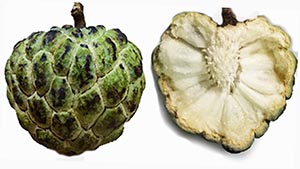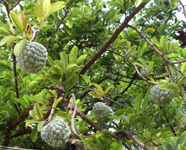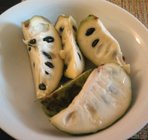Custard apple Nutrition facts
Custard apple is a delicious, pleasantly fragrant fruit in the Annona family. The fruit is popular for its sweet and slightly tangy, creamy-textured flesh. It is also known as bullock's heart in the English speaking countries.
Botanically, the custard is a "multiple-fruit" wherein the fruit is developed from the merger of several individual flowers (ovaries) into a large fruit mass (infructescence).
Scientific name: Annona reticulata.
 |
| Custard apples. |
The custard apple plant is a large shrub belonging to the Annonaceae family. It is native to the tropical rainforests of Central America and naturalized in many parts of the world, spreading along the tropical stretches, from South America to Africa and Asia.

|
| Sugar-apple (Atis fruit)-Annona squamosa. |
Custard apple is a globular, round to heart-shaped fruit with polygonal indentations on its surface. Many cultivars exist, and depending upon the variety there can be green, brown, yellow, or maroon fruits.
Custard apple features tough, outer skin. Inside, individual arils consist of cream-white sheath enveloping single, glossy, deep brown color seeds. The flesh just underneath its surface has a granular texture. Skin and seeds are inedible and discarded. Its flavor is described as a reminiscence of mangosteen, sweet and pleasantly tangy, melts inside the mouth.
Custard apple is smaller in size than cherimoya (A. cherimola), Pond apple (A. glabra) and soursop (A. muricata) but a bit larger than Sugar apple (Atis fruit) (A. squamosa) is grown abundantly in the Philippines. Oftentimes, Sugar apple is termed interchangeably with custard apple.
Health benefits of custard apple
Custard apple has relatively more calories than cherimoya. 100 g of the fruit carries 101 calories against 56 calories of cherimoya. The major portion of the calories comes from simple carbohydrates. It, however, contains no saturated fats or cholesterol.
As in other Annona family fruits, custards also contain several polyphenolic antioxidants. Among them, the most prominent are Annonaceous acetogenins. Acetogenin compounds such as asimicin and annonacin are potent cytotoxins. These compounds have been found to have anti-cancer, anti-malarial, and de-worming properties.
Custards composed of more vitamin-C (19.2 mg/100 g) than those of in cherimoya. Sugar apples, however, carry the highest (36.3 mg/100 g) amount of this vitamin among all the Annona fruits. Vitamin C is a powerful natural antioxidant. Consumption of fruits rich in vitamin C helps the human body develop resistance against infectious agents and scavenge harmful, pro-inflammatory free radicals from the body.
Custard apple is a modest source of B-complex vitamins, especially vitamin B-6 (pyridoxine, 17% per 100 g)). Pyridoxine helps keep up GABA neurochemicals in the brain. High GABA levels in the blood help calm down nervous irritability, tension, and headache ailments.
Custards contain minerals such as calcium, copper, magnesium, iron (9% of RDI per 100 g), and manganese. Additionally, they compose more potassium (382 mg per 100 g) than cherimoya (287 mg per 100 g).
| Principle | Nutrient Value | Percent of RDA |
|---|---|---|
| Energy | 101 Kcal | 5% |
| Carbohydrates | 25.20 g | 19% |
| Protein | 1.70 g | 3% |
| Total Fat | 0.60 g | 3% |
| Cholesterol | 0 mg | 0% |
| Dietary Fiber | 2.4 g | 6% |
| Vitamins | ||
| Niacin | 0.500 mg | 3.5% |
| Pantothenic acid | 0.135 mg | 2.5% |
| Pyridoxine | 0.221 mg | 17% |
| Riboflavin | 0.100 mg | 8% |
| Thiamin | 0.80 mg | 7% |
| Vitamin A | 33 IU | 1% |
| Vitamin C | 19.2 mg | 32% | Electrolytes |
| Sodium | 3 mg | <1% |
| Potassium | 382 mg | 8% |
| Minerals | ||
| Calcium | 30 mg | 3% |
| Iron | 0.71 mg | 9% |
| Magnesium | 18 mg | 4.5% |
| Manganese | 0.093 mg | 4% |
| Phosphorus | 21 mg | 3% |
| Phyto-nutrients | ||
| Epicatechin | 5.6 mg | -- |
| Proanthocyanidin monomers | 6.2 mg | -- |
| Proanthocyanidin dimers | 14.2 mg | -- |
Selection and Storage
Fresh Annonaceae genus fruits can be readily available in the US all around the seasons. Custard apples arrive in the markets from July to November in the Southern and Central states. While buying, look for fresh, light yellow, compact, completely mature fruits with an intact thick stems. Completely grown fruits continue to ripen at home at room temperature. If you want to buy ripe fruits, look for those featuring soft, sweet, and musky aromas that can be appreciated from a distance. Avoid very soft, mushy, broken, cracked, or split skin fruits as they may carry risk.
At home, store unripe fruits in a fruit basket where they continue to ripen and stay well for another 4-5 days. Ripe fruits, however, should be used early. Custards, like other Annona fruits, cannot be stored in the refrigerator for an extended period as they sustain a chilling injury. However, juiced or pureed, the fruit may be kept inside the freezer for several weeks.
Preparation and Serving tips
Simply wash the fruits to remove surface dirt. Mop them dry using a soft towel. Fresh ripe fruits can be eaten on their own without any additions or seasoning. Gently pull apart the fruit to expose cream-white arils inside. You can use a spoon to scoop edible flesh. Spit out seeds as they are inedible.
Here are some serving tips:

|
| Custard apple fruit slices. Photo: bobman |
The fruit is better enjoyed out of hand on its own, without any additions or seasonings.
Puree fresh pulp and mix with other fruits in salads or can be used for ice-cream toppings.
Custard apple milkshake is a refreshing drink in India.
Tart flavored guanabana or soursop can be mixed with honey, sugar, milk, lemon, and ice; and served chilled as sorbet or with other fruit cocktails and milkshakes.
Safety profile
Custard apple seeds and leaf parts contain toxic alkaloids, and therefore, should not be consumed. Do not chew seeds inside the mouth as this releases toxins. If consumed accidentally, the whole seed would not pose any threat as it comes out of the gastrointestinal tract undigested. (Medical disclaimer.)
≻≻-You may also like to read- Cherimoya fruit nutrition facts and health benefits.
≻≻-Back to Fruits from Custard Apple. Visit here for an impressive list of all varieties of fruits with complete illustrations of their nutrition facts and health benefits.
≻≻-Back to Home page.
Further resources:
United States Department of Agriculture- National Nutrient Data base.
Custard apples-Australian custard apples.